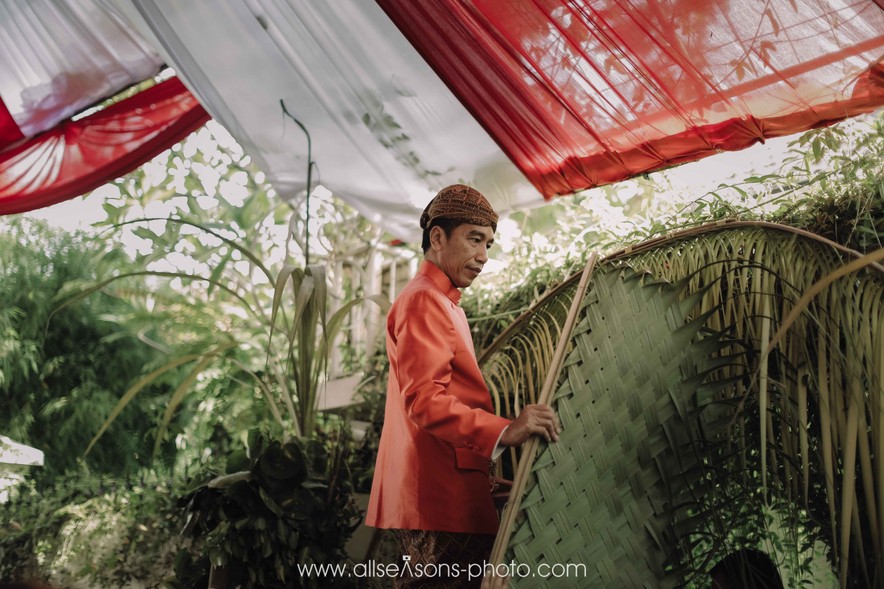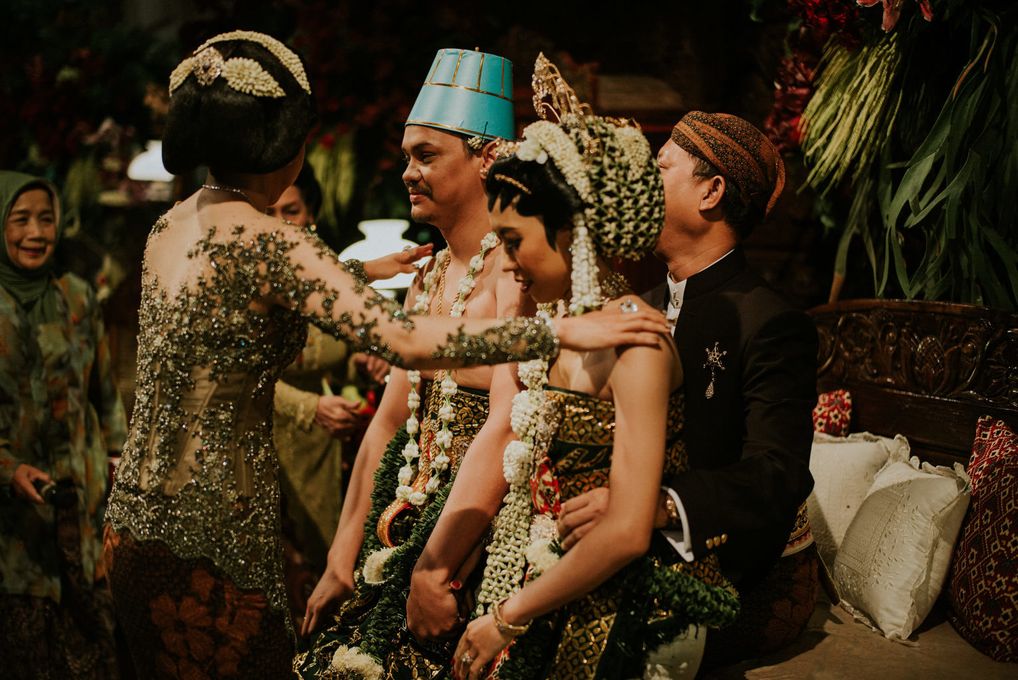When it comes to traditional wedding processions, brides and grooms might be familiar with each and every step of the ritual. Even so, don't go through these steps with no understanding about its meaning. On this article, we have oulined every procession for a Javanese traditional wedding which is grouped into two big processes. Whether it be the hajatan procession or the main affair, each contains certain rituals that hold endearing meanings and prayers for the married couple.
HAJATAN PROCESSION
As the preparation phase for the upcoming wedding, this procession is held to ward off of any mishaps and hope for the wedding to go smoothly from beginning to the very end.

Photography: All Seasons Photo
1. Placing the tratag and tarub
Placing the tratag (decorations for the pavillion) and tarub (a garnish from janur or newly grown coconut leaf) on the entrance is a sign that this family is holding hajatan for their in-laws. The arching yellow janur signifies hope for blessings and prosperity for the bride and groom.

Photography: PPF Photography & Videography
2. Kembar mayang
This time, the ornament made from arrangements of roots, stems, leaves, flowers and fruits is believed to bring insight and motivation for both the bride and groom in their marriage life. Usually, the array of leaves are entwined to a stem of banana tree to resemble the shape of mountains, keris, whips, umbrellas, grasshoppers and birds.

Photography: Pyara
3. Placing the tuwuhan
Tuwuhan or plants are placed on the siraman spot. You can also add some fruits like a bunch of banana on each side as a hope that the bride and groom will be blessed with children.



Photography: Davy Linggar Photography
4. Siraman
The word siraman literally means showering with water. On this procession, there will be seven people showering the bride and groom with water. Later on, the father of the bride will finish off the ritual which signifies cleaning of self before continuing to the next processions. Aside from concluding this procession, the father of the bride will also carry the bride to the bridal room.


Photography: Terralogical
5. Adol dawet
After siraman, both sets of parents will held be selling dawet (a sweet dessert) to the guests that have been attending the previous ceremonies. Even though it's called sellling, the trade itself doesn't use money as an exchange, instead it uses kreweng, a piece of coin made of clay as a symbol of life from the earth. On this procession, the mother of the bride will be selling the dawet, while the father holds an umbrella for her. The meaning behind this is to give an example for their children that in the future, they need to help each other in marriage.

Photography: Kamala Studio
6. Cutting the tumpeng
Tumpeng is a traditional food that consists of cone-shaped rice with a variety of side dishes that are arranged around it on a large round tray made of bamboo. In the Javanese ritual, tumpeng is identified as a symbol of prosperity due to its mountain-like shape. The procession of tumpeng cutting will be done by the father and mother by taking the top of the rice and side dishes.

Photography: All Seasons Photo
Then, the father and mother of the bride or groom will be feeding their child as a sign of last responsibility before sending off their kids for marriage.

Photography: Davy Linggar Photography
8. Planting the hair strand and releasing the rooster
Planting the hair strand of the bride or groom means that all bad things are kept away from the household of both children. Afterwards, it will be continued with the release of the black rooster that marks that both parents wholeheartedly let his daughter to live independently.

Photography: Iluminen
6. Midodareni
The meaning of the word midodareni is angel, so the intention of this procession is for the bride to look as stunning as an angel from heaven on the wedding day. The night before the wedding, the bride is forbidden to meet her future husband, and can only be accompanied by her family members.
MAIN PROCESSION:
On the wedding day is the main affair, the peak of all the processions that has been done. After the wedding ceremony, there are a few processions, each with its own meaning, to wish for happiness for the bride and groom in their marriage.

Photography: PPF Photography & Videography
1. Wedding ceremony
On the ceremony, the bride and groom will state their vows in front of the clergy, parents, guardians, and guests to inaugurate their marriage religiously. On this occasion, the bride and groom will be wearing white Javanese traditional attires to signify purity.
2. Panggih ceremony:
The next procession is the panggih ceremony which means 'meet' in Javanese. The ceremony itself consists of 8 rituals that will prepare them for marriage.

Photography: Le Motion
i. Balangan gantal
Gantal or sirih which is tied by a white string will be thrown by the couple at each other. While the husband throws the gantal to his wife's chest as a sign that he has stolen her heart, the wife will point the gantal to her husband's knee as a sign of devotion.

Photography: Iluminen
ii. Ngidak tagan / Nincak endog
The rite of stepping on a raw egg by the groom is held with the hope that he will be blessed with children because they have become one family. Then, the bride will wash his feet as a sign of love.

Photography: PPF Photography & Videography
iii. Sinduran
Red and white sindur fabric is hoped to bring courage to the bride and groom to start their marriage with passion. On this rite, they will be clad with sindur fabric while being guide to the altar.

Photography: Iluminen
iv. Bobot timbang
After both the bride and groom sat on stage, they will sit on their father's lap and be weighed. The mother of the bride then will ask who weighs more, to which the father will answer that the two weighs the same. With this conversation, they hope the couple will know that they are loved the same.

Photography: Trevo Pictures
v. Drinking rujak degan
The literal meaning of rujak is a drink made of shredded young coconut. The tradition of drinking coconut water is done in turn with one glass for the whole family. Starting from the father, to the mother and given to the couple. This coconut water is treated as holy water that can cleanse the spirit of the whole family.

Photography: Antijitters Photo
vi. Kacar kucur
This rite is done by the groom who will sprinkle coins, along with basic household needs such as rice or seeds to his wife as a symbol that he will be responsible and provide for his family.

Photography: Trevo Pictures
vii. Dulangan
This rite is a sign that the couple will help and love each other until grey and old by feeding each other three times.

Photography: PPF Photography & Videography
viii. Sungkeman
The whole procession of the Javanese traditional wedding is concluded with sungkeman procession, which is done by kneeling in front of both sets of parents as a sign of gratitude that they have raised them up until they can lead a new life with each other.
We also gained additional advice from the expert, Mita Hardo of Mamie Hardo who devoted in enhancing the beauty of Javanese brides-to-be for ten years. She gives us this recommendation for immediate families as well as future brides and grooms, "For successful rites, the most important tip would be praying to God so that all the preparation from the main event to the marriage life can run smoothly. However, there's also a contribution from the experts who can help to make the entire event run even more flawlessly. Be wise in determining the person who will handle your traditional wedding and also, the wedding organizer who will be in charge with these sacred rituals. Make sure they are the people who you can rely on the most. For me personally, future brides and grooms as well as their families are the stars of the celebration. They don't have to think about anything else, but the meaning behind each the ritual itself."




